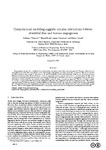Mostrar o rexistro simple do ítem
Computational modelling suggests complex interactions between interstitial flow and tumour angiogenesis
| dc.contributor.author | Vilanova, Guillermo | |
| dc.contributor.author | Burés Muñiz, Miguel | |
| dc.contributor.author | Colominas, Ignasi | |
| dc.contributor.author | Gómez, Héctor | |
| dc.date.accessioned | 2024-01-29T17:01:03Z | |
| dc.date.available | 2024-01-29T17:01:03Z | |
| dc.date.issued | 2018 | |
| dc.identifier.citation | Vilanova Guillermo, Burés Miguel, Colominas Ignasi and Gomez Hector (2018) Computational modelling suggests complex interactions between interstitial flow and tumour angiogenesis. J. R. Soc. Interface. 15: 20180415. http://doi.org/10.1098/rsif.2018.0415 | es_ES |
| dc.identifier.uri | http://hdl.handle.net/2183/35199 | |
| dc.description | Versión aceptada de http://doi.org/10.1098/rsif.2018.0415 | es_ES |
| dc.description.abstract | [Abstract:] Angiogenesis, the growth of capillaries from pre-existing ones, plays a key role in cancer progression. Tumours release tumour angiogenic factors (TAFs) into the extracellular matrix (ECM) that trigger angiogenesis once they reach the vasculature. The neovasculature provides nutrients and oxygen to the tumour. In the ECM, the interstitial fluid moves driven by pressure differences and may affect the distribution of tumour TAFs, and, in turn, tumour vascularization. In this work, we propose a hybrid mathematical model to investigate the influence of fluid flow in tumour angiogenesis. Our model shows the impact of interstitial flow in a time-evolving capillary network using a continuous approach. The flow model is coupled to a model of angiogenesis that includes tip endothelial cells, filopodia, capillaries and TAFs. The TAF transport equation considers not only diffusive mechanisms but also the convective transport produced by interstitial flow. Our simulations predict a significant alteration of the new vascular networks, which tend to grow more prominently against the flow. The model suggests that interstitial flow may produce increased tumour malignancies and hindered treatments. | es_ES |
| dc.description.sponsorship | H.G., M.B. and G.V. were partially supported by the European Research Council (contract no. 307201). I.C. was partially supported by Consellería de Cultura, Educación e Ordenación Universitaria of the Xunta de Galicia (grant no. GRC2014/039). | es_ES |
| dc.description.sponsorship | Xunta de Galicia; GRC2014/039 | es_ES |
| dc.language.iso | eng | es_ES |
| dc.publisher | Royal Society | es_ES |
| dc.relation | info:eu-repo/grantAgreement/EC/FP7/307201 | es_ES |
| dc.relation.uri | http://doi.org/10.1098/rsif.2018.0415 | es_ES |
| dc.rights | Atribución 3.0 España | es_ES |
| dc.rights.uri | http://creativecommons.org/licenses/by/3.0/es/ | * |
| dc.subject | Angiogenesis | es_ES |
| dc.subject | Interstitial flow | es_ES |
| dc.subject | Mathematical modelling | es_ES |
| dc.subject | Phase field | es_ES |
| dc.title | Computational modelling suggests complex interactions between interstitial flow and tumour angiogenesis | es_ES |
| dc.type | info:eu-repo/semantics/article | es_ES |
| dc.rights.access | info:eu-repo/semantics/openAccess | es_ES |
| UDC.journalTitle | Journal of the Royal Society Interface | es_ES |
| UDC.volume | 15 | es_ES |
| UDC.issue | 146 | es_ES |
| dc.identifier.doi | 10.1098/rsif.2018.0415 |
Ficheiros no ítem
Este ítem aparece na(s) seguinte(s) colección(s)
-
GI-GMNE - Artigos [54]
-
OpenAIRE [266]






